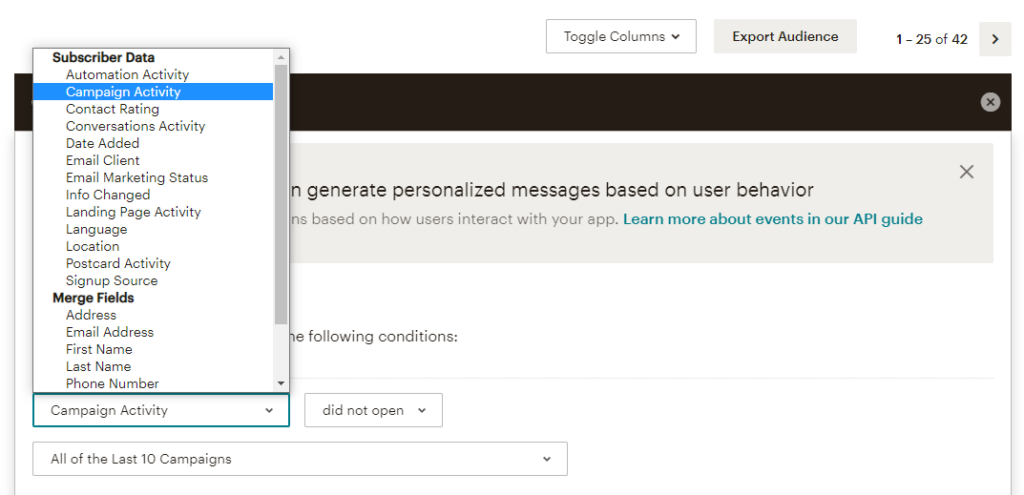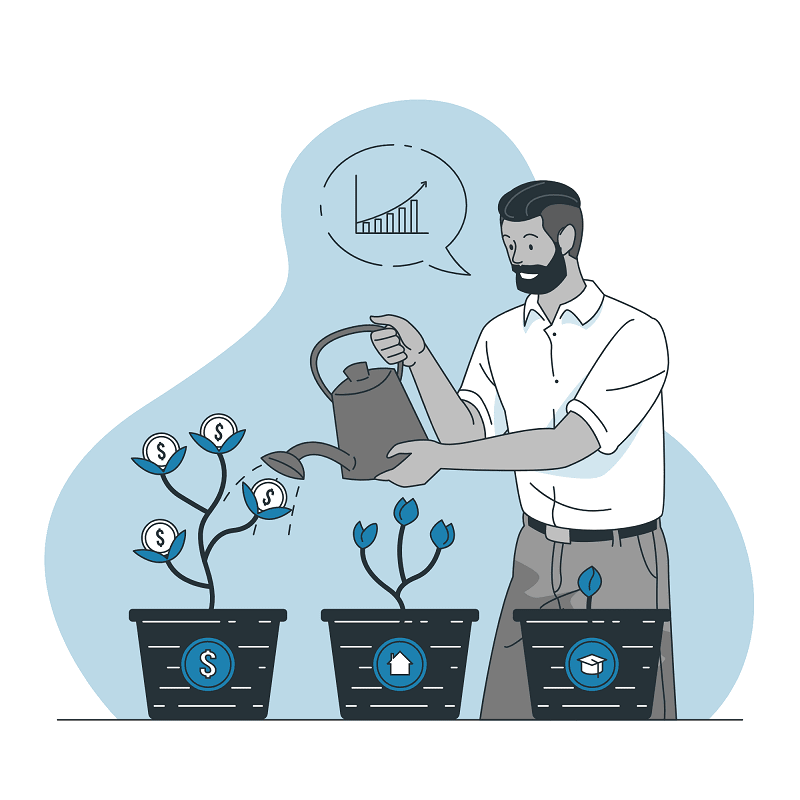Nowadays, most people are extremely overwhelmed with information. Exposure to social media as well as an overflowing number of daily emails are leading us to a continuous circle of “infoxication”.
If you want your marketing to stand out in this sea of information overload, Mailchimp offers all the tools you need to grow your email list.
How to grow your email list
A successful campaign must always offer something helpful and beneficial to the recipient. Also, getting to know your subscribers and connecting with them is the number one priority to grow an email list.
Once you know the main core of who your audience is, you can begin crafting the style, voice and the overall expression of your newsletter.
In the text below, we’ll look into 10 things you can do to grow your email list and how to build a relationship with your subscribers.
1. Have something valuable to say
The prime concern and motivation of your email’s content is offering value.
Whether it is sending a marketing email or creating content for your brand, you need to offer useful information to your recipients, but making sure you don’t give everything away for free.
A common mistake is making a huge investment in adverts that may not be in line with the email’s main topic of discussion. For instance, trying to persuade people to subscribe by launching an online draw.
In some cases draws can be useful to encourage sales but is not the right approach to set up a healthy subscription list.
The main goal is striving for a win-win situation that works for your business and your customers.
2. Good writing is essential

In addition to communicating valuable information to your email list, good writing should be the backbone of any successful campaign.
Before sending a marketing email you should be asking yourself questions like: What is the motivation for sending it? What do I want to communicate? How can I help my subscribers and how can I make their life better?
If the answers to these questions are not clear yet, rethink them because it only takes one unclear email to disengage your audience.
A concise, well written text with a specific call-to-action can make wonders for your email marketing. Don’t be afraid to try different approaches and mix things up with your copy and subject lines.
And the good news is that it doesn’t have to sound fancy, just as long as it’s clear, well presented and straightforward.
Pro tip: Before hitting the “send” button, make sure to read everything out loud to avoid any forced, dull or redundant sentences. Don’t fall in the easy path of cliched marketing references that will only try to manipulate your audience. Honesty is key.
It doesn’t hurt to learn from the best and check Mailchimp’s style guide.
3. Mastering copy and subject lines
While content is king, a subject line is the first thing your subscribers will lay their eyes on. A great subject line will draw people in and is one key factor to engage with your audience.
To grab their attention, you need to come up with catchy, compelling and honest subject lines. Take your time to analyze the main goal of your campaign and brainstorm the best possible ideas.
In addition to grabbing their attention, keep in mind that the subject line must summarize what your campaign is about.
Be playful, measure engagement through multivariate testing campaigns, tease, but also make sure you’re accurate and informative so readers know opening that email is worth their time.
4. Lose the formality
To establish a relationship with your audience, you must define the main features and aspects of your average customer. This step will let you identify the level of formality you want to address them with in your marketing.
Email marketing actions usually make the mistake of being too formal and sometimes it pays off to do exactly the opposite.
To bond with your audience you can develop a communication tone that is not afraid to use play on words whilst staying in line with the brand’s identity.
One way to engage with your subscribers and create a closer atmosphere with them is building a set of inside jokes. Setting a familiar tone will help you find a proper voice and identity.
5. Formatting is key
At this point you may have come up with great content for your marketing but let’s face it, an uncomfortable format will alienate readers, because reading on a screen is already as hard as it is.
Avoid huge blocks of text and evenly divide the text into paragraphs. Make sure that it looks comfortable to read.
Take advantage of all tools that Mailchimp offers for designing emails:
- Use bullet points to break the format and use bold text to highlight important texts.
- Images and video are great tools to illustrate your message and to rest the eyes of the reader.
- Use dividers when necessary.
- Make sure to leave some white space between paragraphs and images.
- A call-to-action button is the best tool to invite your subscribers to click on whatever you want to sell or communicate.
6. Make a pact with your audience (and keep it)
If you’re keen on building a loyal email list, be sure to deliver them what you promised. Meaning that if you commit to send marketing emails once a week for example, you must respect that agreement.
Not complying to this pledge might take your audience to either forget about you if you let too much time pass between campaigns (thus marking your email as spam) or getting them to distrust your brand.
7. Keep your lists clean
Having a clean list doesn’t have to do anything with the concept of cleaned contacts. Even the best curated email lists will have a few “ghosts” here and there. Ghost contacts are those who are subscribed to your marketing but never get to open them.
Whilst a sizable list with thousands of subscribers is any marketer’s dream, having a huge audience that doesn’t engage with your emails might be detrimental in the long run.
Ghost contacts somehow have lost interest in your marketing but at the same time, won’t bother to click the unsubscribe button. You might be asking yourself: how can that hurt my contact list?
Well, for starters, it affects your engagement and open rates numbers by keeping them below average. On the other hand, a gigantic audience with low engagement can also cost you more money.
Keep in mind that Mailchimp pricing plans are based on the number of subscribers you have. So if you’re storing a large audience that at the same time doesn’t translate into sales, you might want to consider archiving long time inactive users.
Pro tip: To get insight of your ghost contacts: click Audience, then “View Contacts”, and New Segment. Select “Campaign activity”, “Did not open” and “All of the last 10 campaigns” from the drop-down menus.

On the bright side, a large but unengaged audience might be a sign that something is not working in your marketing so it can trigger a warning that you need to reevaluate your strategy and identify the problem.
You can choose to prepare a campaign to try and re engage inactive users or simply choose to archive them. Deleting contacts cannot be undone and is only recommended for GDPR purposes (which takes us to the next bullet point).
8. Stick to the rules of email marketing

Email marketers in the European Union have to stick to the GDPR (General Data Protection Regulation) compliance. This is a European law regarding privacy that regulates how the personal data of individuals is processed.
It requires companies to ask potential subscribers for permission before sending any marketing campaigns.
While it doesn’t sound any fun, Mailchimp makes it really simple for you, with user-friendly tools that help you comply with the GDPR in a straightforward manner.
You can easily set up single opt-in, double opt-in options as well as the possibility to respond quickly about the personal data stored in your account, allowing you to have:
- Right of access. Lets you export data from your contacts to prove consent.
- Right to be forgotten. When contact data becomes anonymous when removing or archiving contacts.
- Right to object. You can choose to exclude your contact’s data if a contact objects to having their personal data processed.
- Right to rectification. Mailchimp lets your contacts edit their own permissions.
- Right of portability. Export any contact data at any time.
Ultimately, to avoid having your Mailchimp emails going to spam, you can invite your subscribers to mark your email as “important” or to add you in their list of allowed senders.
9. Keeping it personal: the path to audience segmentation
Creating segments in Mailchimp is the first step in order to get more personal with your audience. Though it requires time and patience, the results may surprise you.
For example, you can target different segments and groups of your audience by geographic location, to those contacts who recently purchased a product, or to those subscribers who didn’t open your last email.
You can build customized segments to meet the conditions you need or you can get started easily using Mailchimp’s pre-built segments that target subscriber engagement, customer behaviour and demographics.
In addition, customizing personal messages using merge tags can benefit you way more than you can imagine, as it helps to improve the relationship and trust with your customers and the open rate of your campaigns.
Sending segmented campaigns can also prevent audience exhaustion, as they don’t receive every single email you sent, only the ones targeted to them.
10. Make use of all resources possible and be patient
In the past few years, Mailchimp has shifted towards a more customer friendly experience, offering all kinds of features to help you build a stronger email list.
Lastly, if you're still wondering how to make your email list grow even more, you can make use of landing pages, surveys and polls, integrations with WordPress, Facebook and all kinds of platforms, social media ads and a complete set of tools that complement the user experience.
Taking advantage of these tools will slowly help you build a stronger email list. Rome wasn’t built in a day and likewise, your email list will take time to grow.
If you’re patient and committed to build a successful relationship with your audience, your list will grow to unimagined heights.


No Comments.